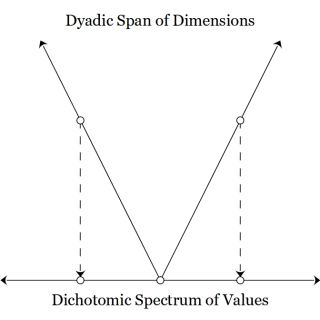Re: Peirce List • Helmut Raulien
- HR:
- As Peircean semiotics is a three-valued logic, I think it bears relevance for the discussion about multiple-valued logic.
Dear Helmut,
The distinction between “k-adic” (involving a span of k dimensions) and “k-tomic” (involving a range of k values) is one of the earliest questions I remember discussing on the Peirce List and the panoply of other lists we ranged across in those heady surfer days. It is critical not to confuse the two aspects of multiplicity. In some cases it is possible to observe what mathematicians call a projective relationship between the two aspects but that does not make them identical.
I’m adding a lightly edited excerpt from one of those earlier discussions as I think it introduces the issues about as well as I could manage today.
Arisbe List • Re: Inquiry Into Isms • k-adic versus k-tomic
Jon Awbrey • 21 Aug 2001
Here is an old note I’ve been looking for since we started on this bit about isms, as I feel I managed to express in it my point of view that the key to integrating variant perspectives is to treat their contrasting values as axes or dimensions rather than so many points on a line to be selected among, each in exclusion of all the others. To express it briefly, it is the difference between k-tomic decisions among terminal values and k-adic dimensions of extended variation.
Standard Upper Ontology List • Dyads
Jon Awbrey • 06 Dec 2000 • 08 Dec 2000
- Jon Awbrey:
- I think we need to distinguish “dichotomous thinking” from “dyadic thinking”. One has to do with the number of values, {0, 1}, {F, T}, {evil, good}, and so on, one imposes on the cosmos, the other with the number of dimensions a person puts on the face of the deep, that is to say, the number of independent axes in the frame of reference one projects on the scene or otherwise puts up to put the cosmos on.
- Tom Gollier:
- Your transmission kind of faded out after the “number of values”, but do you mean a difference between, say, two values of truth and falsity on the one hand, and all things being divided into subjects and predicates, functions and arguments, and such as that on the other? If so, I’d like to second the notion, as not only are the two values much less odious, if no less rigorous, in their applications, but they’re often maligned as naive or simplistic by arguments which actually should be applied to the idea, naive and simplistic in the extreme, that there are only two kinds of things.
- Jon Awbrey:
- There may be a connection — I will have to think about it — but trichotomic, dichotomic, monocotyledonic, whatever, refer to the number of values, 3, 2, 1, whatever, in the range of a function. In contrast, triadic, dyadic, monadic, as a series, refer to the number of independent dimensions involved in a relation, which could be represented as the axes of a coordinate frame or the columns of a data table. As the appearance of the word “independent” should clue you in, this will be one of those parti-colored woods in which the interpretive paths of mathematicians and normal folks are likely to diverge.
- A particular type of misunderstanding may arise when people imbued in the different ways of thinking try to communicate with each other. The following figure illustrates the situation for the case where k = 2.

- This shows how the “number of values” thinker projects the indications of the “number of axes” thinker onto the linear spectrum of admitted directions, oppositions, or values, tending to reduce the mutually complementing dimensions to a tug-of-war of strife-torn exclusions and polarizations.
- Even when the tomic thinker tries to achieve a balance, a form of equilibrium, or a compromising harmony, the distortion due to this style of projection will always render the resulting system untenable.
- Probably my bias is evident.
- But I think it is safe to say, for whatever else it might be good, tomic thinking is of limited use in trying to understand Peirce’s thought.
- Just to mention one of the settings where this theme has arisen in my studies recently, you may enjoy the exercise of reading, in the light of this projective template, Susan Haack’s Evidence and Inquiry, where she strives to achieve a balance or a compromise between foundationalism and coherentism, that is, more or less, objectivism and relativism, and with some attempt to incorporate the insights of Peirce’s POV. But a tomic thinker, per se, will not be able to comprehend what the heck Peirce was talking about.
Resources
cc: Cybernetics • Ontolog • Peirce List (1) (2) • Structural Modeling • Systems Science

Pingback: Survey of Semiotics, Semiosis, Sign Relations • 1 | Inquiry Into Inquiry
Pingback: Sign Relations, Triadic Relations, Relation Theory • Discussion 4 | Inquiry Into Inquiry
Pingback: Sign Relations, Triadic Relations, Relation Theory • Discussion 5 | Inquiry Into Inquiry
Pingback: Survey of Semiotics, Semiosis, Sign Relations • 2 | Inquiry Into Inquiry
Pingback: Survey of Semiotics, Semiosis, Sign Relations • 3 | Inquiry Into Inquiry
Pingback: Survey of Semiotics, Semiosis, Sign Relations • 4 | Inquiry Into Inquiry
Pingback: Survey of Semiotics, Semiosis, Sign Relations • 5 | Inquiry Into Inquiry